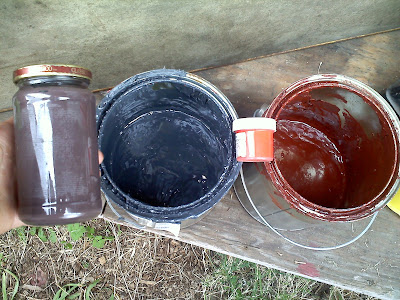This weekend I was so ready to post
that I had finally started the engine.
Instead I sabotaged that idea by doing things in order.
 |
| 1940 ford dash |
The engine wiring was basically done,
but the dash wiring was a little messy.
Somehow I was able to pull all these wires out of there!
 |
| wired |
You can see I had a thing for black wires back then.
That's why there were multiples.
If I thought that a wire was bad I'd just run another one.
Some were gauge wires that I'll have to redo,
but since it's a different engine the locations have changed.
 |
| template |
Before there had been a series of hidden switches under the dash.
Over time the switches were loose,
and really I'll admit I forgot what the secret starting sequence was.
 |
| busted |
Actually I did remember,
but this dang busted switch had tricked me,
as nothing was working right.
 |
| control panel |
It was obvious what was needed.
A couple minutes with the grinder and some scrap aluminum,
and a little control panel cleaned everything up.
 |
| wired! |
All the wiring was then rerouted.
What a rats nest huh!?
It's actually not too bad if you've studied it for a couple years.
The bottom fuse panel is fed by that top right black wire,
which holds the master fuse,
which then feeds all the basic switches - lights, pump, ignition, fan etc.
The junction box is routed to the light switches on the right side,
than back over the jumpers to the light outs on the left.
The ballast resistor isn't used with the electronic ignition,
but I'll leave it there in case I change back to points someday.
That little relay box is for the starter switch,
which I still don't quite understand why it's needed!
Like I said it's basic!
I'll bundle the wires with zip ties later on,
after the gauge wires are installed.
 |
| exhaust RTV |
At some point I realized the engine wasn't going to start.
This was the perfect time to finally seal up the headers.
I like to use straight RTV with no gasket.
The trick is to bead up the header flange,
with a light coat on the block,
and let it skin over for a couple minutes.
Than bolt on the headers but not too tight.
Go get distracted for a bit,
than come back and do a good torquing.
Make sure you file the flanges and scrape all the paint/gasket off.
The most important step is letting it cure for at least a day,
or you'll blow out the RTV.
 |
| exhaust RTV |
The wild card project is the transmission TV cable.
I don't want to use a Lokar aftermarket version,
as I've got the original Lincoln/Ford cable,
and I also really like the simple design.
 |
| holey chit |
Here's part I of the "how to rig a TV cable"
The first problem is the 2100 carburetor is not set up for this unit.
The solution was to file out a thick SS washer for the bushing...
 |
| bushed |
Measure the exact 1:1 location on the throttle lever...
(thanks Ricky for the tip!)
 |
| precision |
Precision looking tool there eh!?
 |
| 1:1 |
Mark for a trim...
 |
| more precision work |
The final 1:1 measurement was adjusted with a little gap,
and everything was tigged up.
 |
| fitting |
Now the carburetor is set up for the Ford TV cable.
 |
| TV modified autolite/motorcraft 2100 carburetor |
Here you can see how the assembly fits on to the new throttle hole.
I'll make a little bracket that holds up the sheath housing to the intake,
and hopefully the box will be able to adjust itself correctly.
 |
| partial TV cable linkage |
That was a huge step as now the carburetor could actually be mounted.
Something would seem wrong welding on a gas filled carburetor!
 |
| 95% complete |
Here you can see there's the last hot wire going to the coil positive,
which also connects to the voltage regulator power side.
The valve covers are also finally bolted down and the oil is filled.
 |
| busted fuel pump |
In a last rush there was a bit of hope to get it started,
until I was viciously reminded that the fuel pump was dead.
Aren't these supposed to last more than 7 years?
Funny thing is,
all I needed to do was swap out the pump and the flathead may have stayed.
Instead I tore up the guts of this car just to fall back to the original problem.
 |
| STD list |
The best part is my STD (shit to do) list is one page.
This includes some really easy things,
which offset the time consuming or expensive things.
It's an illusion as "filling oil" has the same space as "build a shifter".
Now instead of getting the glassy stare,
I can pick a project and get it crossed off.
Okay more later...
TP
























































